Server Disk Space Summary
Starting in IP Fabric version 5.0.0, the virtual appliance deploys as one hard disk installation instead of two disk volumes.
IP Fabric appliance is using LVM type for root and swap partitions. On a default installation, the swap has 16GB, and root has ~72GB of disk space.
We automatically resize the boot disk as follows:
- resize primary partition to full size of the disk
- resize extended partition to full size of primary partition
- extend
ipfabric-vg/rootto+100%FREE - online resize
ext4partition
Increasing Disk Space On IP Fabric Appliance
If you need any help with a disk space expansion, please contact our Support Team
Resizing Root/First Disk
The easiest way how to resize IP Fabric system disk is to
-
Shutdown the appliance
-
Resize root/first disk to a desired size
-
Start virtual machine
cloud-init will take care of resizing this disk.
Expanding System Volume By Adding Additional Disk(s)
If you want to add secondary or any additional disk as a system disk, you will need to manually add it to ipfabric-vg/root volume.
To do that follow LVM resource:
Local Backup Disk
Backup Disk
Backup disk is not present by default! Please add a new virtual disk to enable local backups.
When enabling local backups, a backup tool creates backups to the /backup directory.
The tool first checks if the local backup directory exists and then the backups are created.
Any additional disk (see hypervisor-specific configuration at the bottom of this page) can be mounted as the backup directory. We recommend using an additional disk located on a different datastore than the root volume for the local backups.
Warning
The backup disk has to be partitioned with LVM. Specifically, the /backup directory must be on the logical volume backup of the volume group backup-vg.
Instructions To Mount a Physical Disk To /backup Directory
Find a device which you want to use as the /backup directory. In this case, vdb.
osadmin@ipfabric:~$ lsblk
NAME MAJ:MIN RM SIZE RO TYPE MOUNTPOINT
vda 254:0 0 76,3G 0 disk
├─vda1 254:1 0 487M 0 part /boot
├─vda2 254:2 0 1K 0 part
└─vda5 254:5 0 75,8G 0 part
├─ipfabric--vg-swap_1 253:0 0 16G 0 lvm [SWAP]
└─ipfabric--vg-root 253:1 0 59,8G 0 lvm /
vdb 254:16 0 20G 0 disk # <- I want to use this device for the /backup directory
-
Create LVM physical volume on the disk
vdb:osadmin@ipfabric:~$ sudo pvcreate /dev/vdb Physical volume "/dev/vdb" successfully created. -
Create the volume group
backup-vg:osadmin@ipfabric:~$ sudo vgcreate backup-vg /dev/vdb Volume group "backup-vg" successfully created -
Use the entire size of the volume group
backup-vgfor creating the logical volumebackup:osadmin@ipfabric:~$ sudo lvcreate -n backup -l 100%FREE backup-vg Logical volume "backup" created. -
Create a filesystem (in this example
ext4) on the logical volumebackup:osadmin@ipfabric:~$ sudo mkfs.ext4 /dev/mapper/backup--vg-backup mke2fs 1.46.2 (28-Feb-2021) Discarding device blocks: done Creating filesystem with 5241856 4k blocks and 1310720 inodes Filesystem UUID: 26bf3259-8421-4b67-ad27-71fa55e57af8 Superblock backups stored on blocks: 32768, 98304, 163840, 229376, 294912, 819200, 884736, 1605632, 2654208, 4096000 Allocating group tables: done Writing inode tables: done Creating journal (32768 blocks): done Writing superblocks and filesystem accounting information: done -
Create a new fstab entry (for example with
sudo vi /etc/fstab):Info
We strongly recommend only LVM partition, LABEL and UUID in
fstab, for more info see Persistent block device naming./dev/mapper/backup--vg-backup /backup ext4 defaults 0 0 -
Create the
/backupdirectory:sudo mkdir /backup -
The logical volume
backupon the diskvdbcan be now mounted with:sudo mount /backup -
Finally, check the output of
lsblk:osadmin@ipfabric:~$ lsblk NAME MAJ:MIN RM SIZE RO TYPE MOUNTPOINT vda 254:0 0 76,3G 0 disk ├─vda1 254:1 0 487M 0 part /boot ├─vda2 254:2 0 1K 0 part └─vda5 254:5 0 75,8G 0 part ├─ipfabric--vg-swap_1 253:0 0 16G 0 lvm [SWAP] └─ipfabric--vg-root 253:1 0 59,8G 0 lvm / vdb 254:16 0 20G 0 disk └─backup--vg-backup 253:2 0 20G 0 lvm /backup
Increase Size of Backup Disk
Suppose you prepared a backup disk with size of 20 GB with the instructions above and you would like to increase its size (for example to 40 GB).
-
Shutdown the IP Fabric appliance.
-
Increase the backup disk’s size at the VM-level (for example to 40 GB).
-
Start the IP Fabric appliance.
-
Log in to the CLI as the
osadminuser. -
Check the status with
lsblk– notice that the diskvdbin this case has 40 GB, but the LVM logical volumebackupstill has only 20 GB:osadmin@ipfabric:~$ lsblk NAME MAJ:MIN RM SIZE RO TYPE MOUNTPOINT vda 254:0 0 76,3G 0 disk ├─vda1 254:1 0 487M 0 part /boot ├─vda2 254:2 0 1K 0 part └─vda5 254:5 0 75,8G 0 part ├─ipfabric--vg-swap_1 253:1 0 16G 0 lvm [SWAP] └─ipfabric--vg-root 253:2 0 59,8G 0 lvm / vdb 254:16 0 40G 0 disk └─backup--vg-backup 253:0 0 20G 0 lvm /backup -
Resize the LVM physical volume:
osadmin@ipfabric:~$ sudo pvresize /dev/vdb Physical volume "/dev/vdb" changed 1 physical volume(s) resized or updated / 0 physical volume(s) not resized -
Resize the LVM logical volume:
osadmin@ipfabric:~$ sudo lvextend -l +100%FREE /dev/backup-vg/backup Size of logical volume backup-vg/backup changed from <20,00 GiB (5119 extents) to <40,00 GiB (10239 extents). Logical volume backup-vg/backup successfully resized. -
Resize the filesystem:
osadmin@ipfabric:~$ sudo resize2fs /dev/mapper/backup--vg-backup resize2fs 1.46.2 (28-Feb-2021) Filesystem at /dev/mapper/backup--vg-backup is mounted on /backup; on-line resizing required old_desc_blocks = 3, new_desc_blocks = 5 The filesystem on /dev/mapper/backup--vg-backup is now 10484736 (4k) blocks long. -
Re-check the status with
lsblk:osadmin@ipfabric:~$ lsblk NAME MAJ:MIN RM SIZE RO TYPE MOUNTPOINT vda 254:0 0 76,3G 0 disk ├─vda1 254:1 0 487M 0 part /boot ├─vda2 254:2 0 1K 0 part └─vda5 254:5 0 75,8G 0 part ├─ipfabric--vg-swap_1 253:1 0 16G 0 lvm [SWAP] └─ipfabric--vg-root 253:2 0 59,8G 0 lvm / vdb 254:16 0 40G 0 disk └─backup--vg-backup 253:0 0 40G 0 lvm /backup -
Also check the size of the filesystem:
osadmin@ipfabric:~$ df -h /backup Filesystem Size Used Avail Use% Mounted on /dev/mapper/backup--vg-backup 40G 19M 38G 1% /backup
Deprecated Resize Wizard
IP Fabric appliance with version lower than 5.0 was using two LVM volumes by default. ipfabic-vg/root for system and data, backup-vg/backup for /backup.
System and data volume was extended over two disks (usually first two). For additional drives, one could choose to extend root or backup volume. This option was discontinued in favor of one system/data disk with the possibility of adding a backup disk.
The original script is still present in the system, but it is discouraged to use it as it expects only the boot disk to be sda, sdb as extended ipfabic-vg/root, and one could choose how sd[c-z] would be used. The new approach with one disk is more versatile and is not limited to sd[a-z] disks.
Deprecated script
This script should not be used anymore. You should run only when you are sure you know what you are doing.
Script location: /opt/nimpee/sys-lvm-resize.sh
Increase Disk Space For VMware
Extend Existing Virtual Disk (For System And Data)
- Open VMware vSphere web console.
- Right click on VM name and select Edit Settings.
- Select Hard disk and change its size.
- Click OK.
- Restart VM (using CLI or web UI).
- Disk space is automatically increased if you resized the first drive.
Add New Virtual Disk (As An Additional Backup Disk)
- Open VMware vSphere web console.
- Right click on VM name and select Edit Settings.
- Click Add New Device → Hard Disk
- Select new size
- Specify Location:
- for system disk expansion is recommended to select Store with the virtual machine
- for backup volume is recommended to select different datastore ideally on a different physical storage
- Click OK
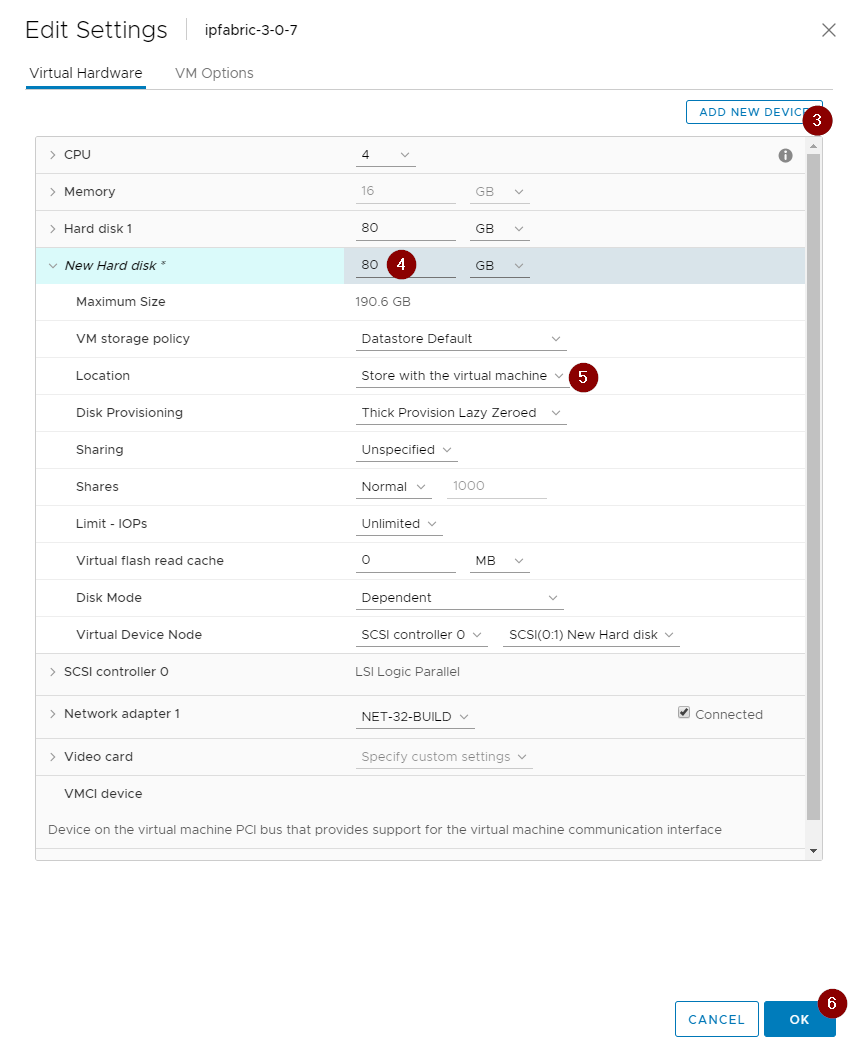
- Launch Remote (Web) Console.
- Reboot(Send Ctrl+Alt+Delete function can be also used) or power on IP Fabric VM.
- Follow Adding additional disk(s) or Example adding disk to backup
Increase Disk Space For Hyper-V
Extend Existing Virtual Disk (For System And Data)
- Open Hyper-V Manager.
- Shutdown VM. (when Started, HyperV won’t let you change any hardware settings)
- Right click on VM name and select Settings.
- Select IDE Controller - Hard Drive - ipfabric-x-x-x-disk1.vhdx
- Click Edit - Choose Action - select option Expand, click Next.
- Set up required disk size and click Finish.
- Start VM.
- Disk space is automatically increased, if you resized the first disk.
Add New Virtual Disk (As An Additional Backup Disk)
- Open HyperV Manager.
- Shutdown VM. (when Started, HyperV won’t let you change any hardware settings)
- Right click on VM name an select Settings.
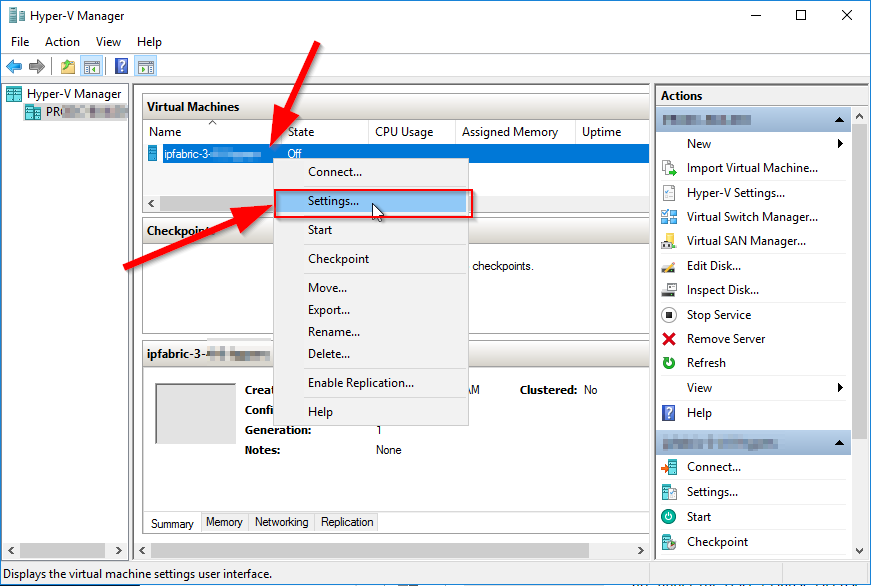
- Select IDE Controller 1 - Hard Drive - click Add
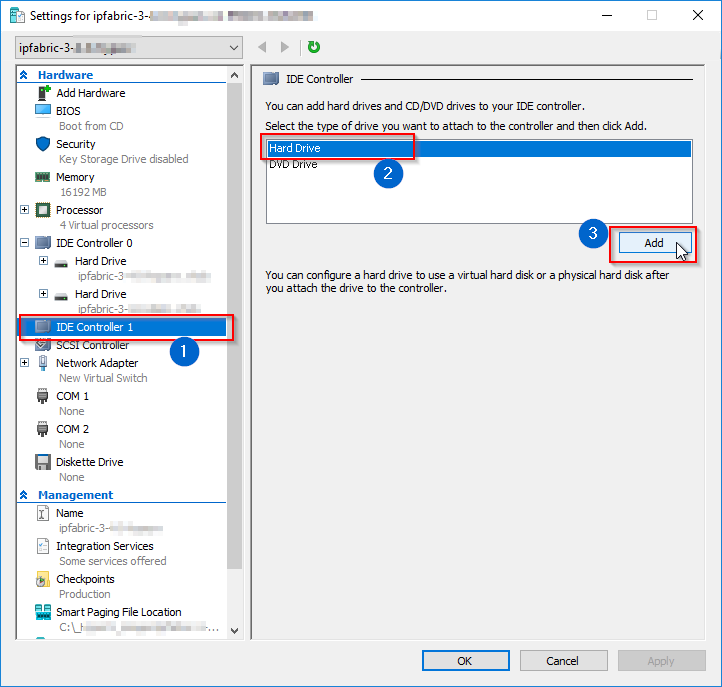
- Select Virtual hard disk - click New - select Choose
Disk Format - select VHDX - click Next.
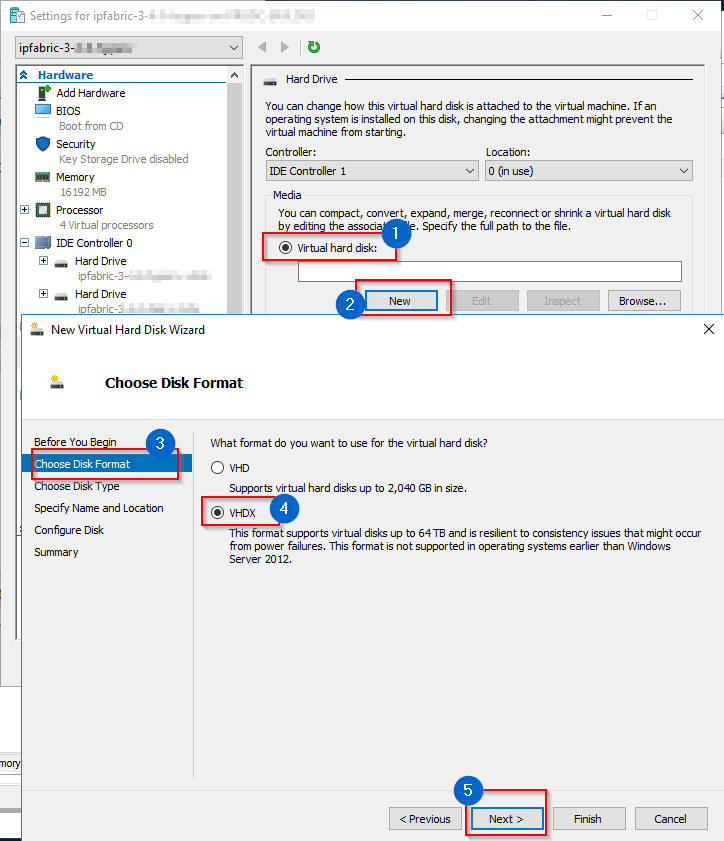
- Select Dynamically expanding - click Next
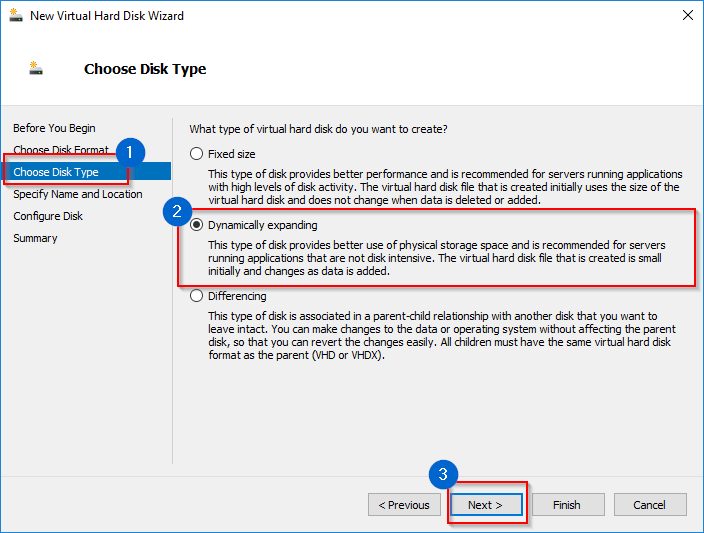
- Specify name and location of disk.
- Configure Disk - select Create a new blank virtual hard
disk - change Size to required value - click
Finish.
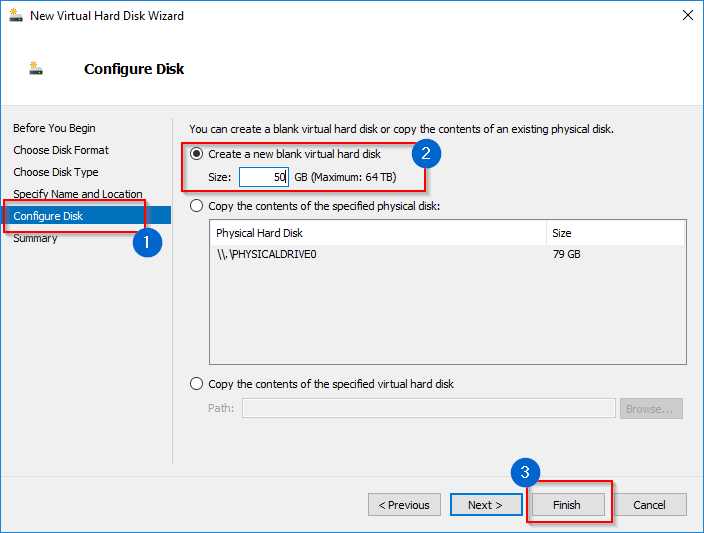
- Apply new disk on Settings window - close Settings.
- Start VM.
- Follow Adding additional disk(s) or Example adding disk to backup